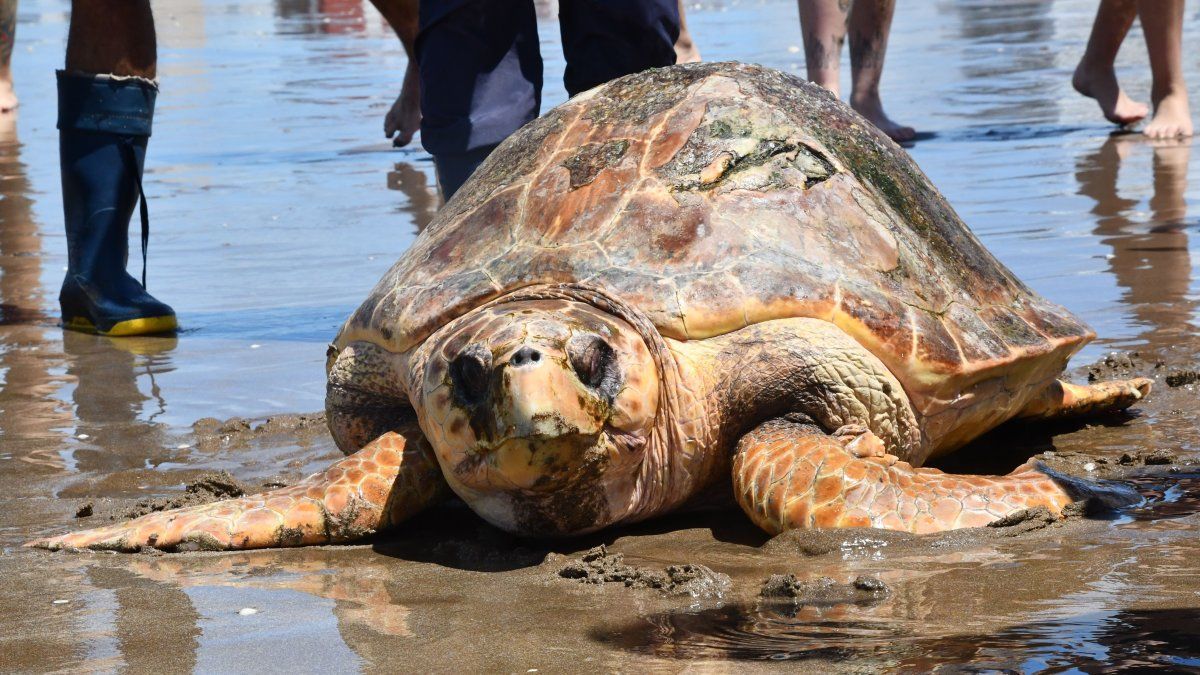A loggerhead turtle (Caretta caretta) He returned to the sea on the morning of this Wednesday, November 20, after going through a three-week rehabilitation process at the Mundo Marino Foundation. Its discovery occurred on October 30 on a beach in the town of Las Toninas, when a neighbor found the stranded marine reptile.
“Every morning I go for a walk from the 22nd slope of Las Toninas to Costa Chica. On that walk I saw a giant turtle and a man who was trying to help him with water. Because of my activity on social networks I started making videos asking for help and I decided to stay with the turtle until I was satisfied that it was in good hands. Fortunately, the Foundation’s van arrived and two incredible people took care of moving it along with the collaboration of everyone who was present,” explained Natalia Nicolás, who, in addition to having found her that October 30, also participated in her return to the sea.
Regarding sex and age, it was a male and adult animal. Until now it was the largest living animal of this species that entered the Mundo Marino Foundation, given that it registered a weight of 130 kilos and a shell more than 1 meter long.
“The animal entered our rescue center very weak, without the ability to react to stimuli and with a wound on its shell that had already healed in the caudal area. As we assumed that he had not been fed for a while, we first proceeded to hydrate him subcutaneously with glucose solutions and salts. Then, once stabilized, we took a blood sample that, although it showed normal blood parameters, showed a low level of glucose and protein. These data confirmed to us that the animal was not feeding. Finally, as a general support treatment, we administer antibiotics and anti-inflammatories,” explained Juana Caferri, veterinary doctor at the Mundo Marino Foundation.
On the other hand, as part of the diagnostic process, x-rays and an ultrasound were performed to rule out the presence of foreign elements inside, compatible with plastic, and a possible drowning syndrome: “Unfortunately, the negative interaction of garbage is common. with these animals. Furthermore, since they have lung breathing, if they get caught in a fishing net, they can drown or suffer decompression syndrome due to sudden changes in water pressure. Fortunately, in the case of this turtle, through the images we took, we ruled out both possibilities,” added Juana Caferri.
Once the first 10 days of rehabilitation had passed, the animal began to eat on its own, showing a good eating and behavioral attitude, as well as adequate swimming. In that sense, the veterinary team at the Rescue center proceeded to discharge him as a veterinary doctor.
The loggerhead turtle is a species that, according to the International Union for Conservation of Nature (IUCN), is in a “vulnerable” state.
Regarding their origin, a large part of the turtles that reach our latitudes come from the beaches found in the northeast of Brazil. Like the rest of the sea turtle species, females return to lay their eggs on the same nesting beach on which they were born. Mating occurs in the water near nesting beaches and occurs every 3 years.
The loggerhead turtle differs from other species by having 5 costal shields on its shell and having a wide and robust beak. Regarding its diet, it is an eminently carnivorous species that feeds on clams, oysters, crabs, sponges, jellyfish, and different types of fish.
Source: Ambito
I am Pierce Boyd, a driven and ambitious professional working in the news industry. I have been writing for 24 Hours Worlds for over five years, specializing in sports section coverage. During my tenure at the publication, I have built an impressive portfolio of articles that has earned me a reputation as an experienced journalist and content creator.




